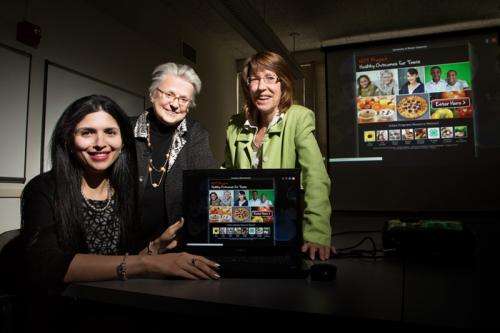Health lessons provided by interactive media easier for youth to swallow

Lecturing teens to eat their vegetables and get more exercise may not motivate them to adopt healthier habits, as many parents know. But will members of the "Facebook generation" learn to eat their broccoli and take more walks if the messages come from electronic games and peers in videos instead?
Researchers at the University of Illinois explored that possibility in a recent study that included more than 200 middle-school youth who were at risk for diabetes or already had the disease. The study compared the effectiveness of interactive online media with that of a passive-learning website at helping young people improve their eating and exercise habits.
Called the Healthy Outcomes for Teens Project, the intervention was adapted from an existing diabetes education website for adults called Your Guide to Diet and Diabetes, also developed at Illinois.
"Research indicates that more than 93 percent of adolescents use the Internet on a daily basis and more than 50 percent are online more than two hours a day," said the study's lead author, Henna Muzaffar, a registered dietitian and postdoctoral research associate in the Division of Nutritional Sciences. "That led us to thinking about using an online format for delivering the intervention for our target population."
Sixth-, seventh- and eighth-grade students from three schools participated in five learning sessions, each about 35 minutes in length, during health or physical education class or after school. One group of students used an interactive website, while their counterparts used a passive, text-based website that contained the same information. Both versions taught skills and concepts such as judging healthy portion sizes and strategies for increasing one's physical activity levels and intake of fruits and vegetables.
During pretesting, most of the students could not identify appropriate portion sizes of different foods, but participants in the active online learning group showed significant improvements after the intervention. Both the active and passive learners also consumed significantly more fruits and vegetables and reduced their consumption of fat.
The students were hungry to learn, the researchers found. About 60 percent of the participants logged in and used the interactive website at home, although that wasn't required. The teens also asked for guidance in helping their parents adopt healthier habits, and sought out information about the role of nutrition in preventing cancer and other diseases.
"Online education is received very well by adolescents, given the increasing amount of time they spend on computers and handheld devices," Muzaffar said. "They like the interactive features. It keeps them more engaged, and they like the flexibility of being able to learn at their own pace. Although this intervention was for diabetes, there is potential for using this venue for other disease processes and other healthy habits that we want to promote in this population."
However, the intervention – which was implemented twice, with different groups of participants – was not as successful at inspiring the youth to increase their physical activity.
During the second trial, the researchers added videos that showed same-age peers demonstrating various exercises, and the revised program included content about coping with stress and dealing with eating-related social pressure.
"In one of the focus groups, one of the children said: 'I can tell you I'm supposed to have an apple instead of the Skittles – but if somebody puts Skittles in front of me, I'm going to eat them,'" said co-author Karen Chapman-Novakofski, who is a professor of nutrition and an Extension specialist. "How do you negotiate that with a friend who thinks you're sharing food? I think that's a really important place that we can go as researchers trying to teach behavior using online technology."
While students found the videos, games, animations and narrated text enjoyable and informative, they were more likely to misinterpret the main points of the videos if the information was presented in audio only. Apprehension was better when students read text while listening to voice-over narration, the researchers found.
U. of I. Extension specialist Jane Scherer and Darla M. Castelli, who is a faculty member at University of Texas at Austin, also were co-authors of the study.
The HOT Project is available on the U. of I. Extension website. The lessons align with Illinois' Common Core Standards, and the online package includes a teacher's guide.
A study about the HOT Project was published recently in the journal Diabetes Technology and Therapeutics.
More information: Diabetes Technology and Therapeutics. online.liebertpub.com/doi/abs/ … 0.1089/dia.2014.0073














